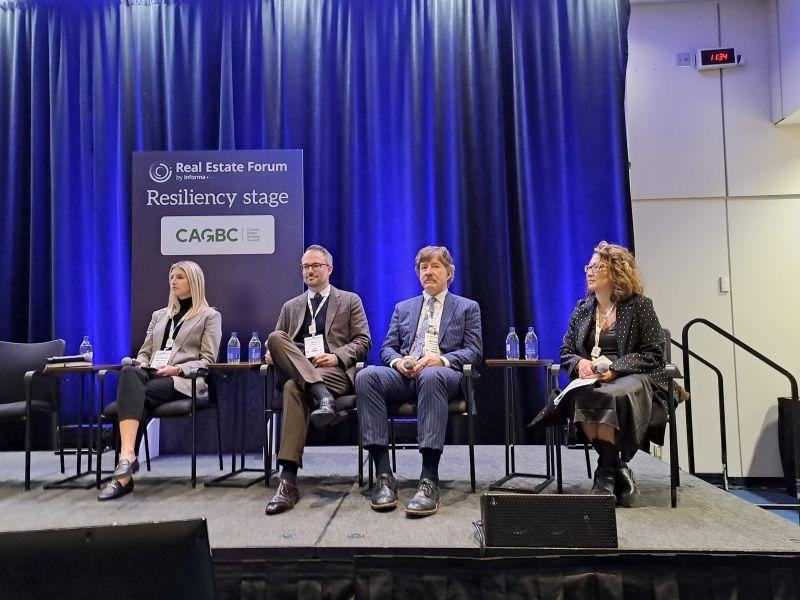Sustainability has become entrenched in conversations about commercial buildings both old and new.

Anna Murray, vice president of sustainability for real estate investment advisors Bentall Kennedy, speaks at the Conflux Canada conference in Ottawa. (Marc Shaw RENX)
Buildings with low environmental impact and efficient use of energy are highly desirable to property investors, making attention to sustainability a key component of the business model for building owners and managers.
During the recent Conflux Canada Conference in Ottawa, Anna Murray, vice president of sustainability for real estate investment advisors Bentall Kennedy, gave a talk on how to accurately communicate the value of sustainability.
“Our teams are doing a lot of really interesting things, but sometimes it’s hard to get the information out of a property and share it around,” said Murray. “We definitely encourage setting up the right framework in that respect so you can have your champions buy in at the ground level and all the way up to the senior level as well.”
Bentall Kennedy’s green commitment
Bentall Kennedy is known for its commitment to green technologies and was recently awarded the Climate Leadership Award for large businesses in the innovator category at the GLOBE Forum 2018. As one of North America’s foremost providers of real estate services – nearly 550 institutional clients with around $47 billion in assets being managed around the continent – the firm has had a lot of chances to refine its approach to explaining the value of sustainable practices.
The Bentall Kennedy approach to sustainability is based on four key pillars: stakeholders, value propositions, performance and governance. The simple concepts are meant to outline the sustainability road map, which can help companies on their journey towards sustainability.
Key stakeholders
Murray began by stressing the importance of key stakeholders, which she believes cannot be overemphasized. Companies dealing with several stakeholders need to accommodate differing goals and needs.
“You can’t be all things to all people,” Murray said. So, it’s important to understand the business needs of stakeholders you are dealing with on a day-to-day basis.
“It’s easy to get caught up focusing all of your efforts and resources on one stakeholder group, and that can sometimes be at the detriment of another group,” explained Murray, who used the example of conflicts of interest between tenants who want to operate in superior environments, and investors looking for a higher return. “Make sure you always have an understanding of who these stakeholders are and what their objectives are.”
The value proposition
Identifying stakeholders and how to relate to their goals leads to the next step of proposing the actual value of sustainability. For investors, the value might be due to lowered operating costs; leasing teams might get a boost in renewal rates and tenant satisfaction; and clients could benefit with better financial performance.
For all of this, the importance of data cannot be overstated. In Murray’s experience, investors place value on a company’s global ranking and tenants want to know what percentage of their buildings are green certified. By keeping accurate data on hand, the value discussion becomes a lot easier to target specifically at your audience.
“What doesn’t get measured, doesn’t get done,” said Murray.
Building performance
Data then directly informs performance, which Murray divided into four categories: targets, benchmarking, disclosure and general progress. Setting targets beyond energy reduction and carbon footprint, taking into account the overall corporate objective, gives direction beyond hitting arbitrary numbers. Sometimes results can be qualitative instead of quantitative.
Internal benchmarking while achieving targets allows companies to see who is performing in what way, providing a diagnostic which shows where the company sits and informing future decisions. Disclosing the information then leads to improvements in the general process.
Collected data must be distilled to its most important pieces so it’s palatable to team members.
“We don’t want that data to just go into a drawer and then be ignored for the rest of the year. It’s a real opportunity to sit down with the team and say ‘this is where you sit, should you so choose, here are the actions we recommend you take in order to drive performance,’ ” said Murray.
Sustainability team advisors
With increased performance, informed by data, the discussion about the value of sustainable practices becomes easier. Getting to good governance requires all the right performance pieces to be in place. To employ all this data and communicate these practices, the sustainability team should be entrenched as advisors to all the other teams in a company.
For Bentall Kennedy, the balance between pushing the agenda and not overloading people with too much information is precarious. Teams and clients have a lot of other work to do, so helping them understand how the sustainability team relates to their functions, and can support their business objectives, is extremely important.







